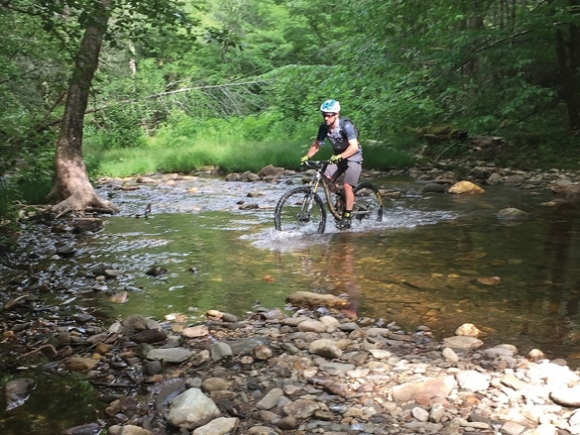Forest management planning process moves forward

While a draft forest management plan is still nearly a year away, a group of recently released documents gives a glimpse into how the U.S. Forest Service might ultimately manage the 1.2 million acres in the Pisgah-Nantahala National Forest over the next 20 years.
Maps showing management areas, goals for each type of management area, descriptions of each of the forest’s unique geographic areas and a list of special interest areas are all contained in the documents that the Forest Service put out for public comment. And, while different stakeholders have different opinions on what’s been written so far, opinion on the Forest Service’s process seems to be running high.
“I can’t commend the Forest Service enough on how they’ve rolled this out and how transparent they’ve been,” said David Whitmire, a hunter and outfitter who is also a member of the Stakeholders Forum for the Nantahala and Pisgah Plan Revision. “I think it’s fantastic.”
“It’s great that the Forest Service is putting a lot of time and energy into setting context,” added Jill Gottesman, conservation specialist for The Wilderness Society’s Southern Appalachian Regional Office and an alternate on the forum.
The management areas
The new documents divide the forest into 12 different geographic areas, distinct landscapes that contain their own unique ecology and identity. With each area, the Forest Service has included a description of the area’s history and notable places, a map of management areas and a list of management goals.
Related Items
Michelle Aldridge, planning officer for the Forest Service, compares the geographic areas to cities and the management areas within them to zoning districts. Just like most cities have areas zoned as residential, commercial and industrial, each geographic area has areas designated for interface, matrix or backcountry management.
It’s a markedly different scheme than the current plan, which defines 21 different types of management areas. In the plan currently under construction, just three management types — interface, matrix and backcountry — would cover the bulk of the forest, with a few other management types — concentrated recreation areas, administrative sites, Appalachian Trail, National Scenic Byways, heritage corridors, Wild and Scenic Rivers, special interest areas and research natural areas, and wilderness — appearing less frequently for a total of 12 different management area types.
“One of the things we heard loud and clear is our (current) plan had too many different management areas,” Aldridge said. “We wanted to provide clarity about where different things could occur, but we thought we could make it a simpler management area concept.”
The three main management types form a sort of gradient across the forest. Interface areas, generally about 1 mile wide, follow existing roads and are the places where human impact and population are likely to be the highest. The matrix area contains the most acreage and serves as a “connective tissue” between the interface and the backcountry. The backcountry, meanwhile, is managed to be remote and often roadless, with large blocks of relatively undisturbed forest.
In the backcountry, management will emphasize habitat for species that need large blocks of older forest to thrive, and while timber harvest will be allowed there, it will be used to accomplish “site-specific restoration goals” and wouldn’t happen frequently, the pre-draft plan says.
Meanwhile, management in the matrix and interface areas will be substantially more active. In both areas, the focus will be on creating young forest habitat to bolster populations of game species, with 650-1,200 acres harvested each year — though more harvest would be possible with funding from partner organizations and use of prescribed fire.
“With expanding opportunities, including with partners where possible, this work could accomplish up to approximately 3,000 to 4,000 acres annually,” the document says.
In the interface areas, management would seek to minimize any impacts to access roads or to the scenic beauty visitors experience as they drive past. Extra care would also be taken to prevent spread of invasive species, as spots closer to roads and other public areas are more susceptible to such issues. Meanwhile, management in the matrix will seek to make young forest more frequent — likely using timber harvest and fire to achieve the goal — than in the interface. Some road construction would be permitted to facilitate such management.
Feedback from stakeholders
Reaction to the preliminary management area designations varies.
“I like the flexibility that they get in those areas,” Whitmire said. “That’s what we look forward to is flexibility to get some of this regeneration work done in the forest. Matrix and interface does a lot of that.”
Whitmire has been an advocate of increased logging in the national forest so as to create more of the young forest habitats that game animals such as grouse and deer need to thrive, and he likes that the new management area scheme provides the possibility of timber harvest across much of the forest. He hopes to see partnerships with other groups allow the Forest Service to boost young forest habitat to somewhere between 10 to 12 percent of the forest’s total acreage.
For her part, Gottesman is withholding judgment on how well the draft management areas might work until more information is released.
“There’s a lot of questions still out there as far as in the interface and matrix areas where different types of restoration and timber management are going to be happening,” she said. “We’d like to see more clearly stated guidelines from the Forest Service on how that does occur in those places.”
“I think it’s a workable concept,” Josh Kelly, public lands biologist for MountainTrue and stakeholders forum member, said of the revised management areas. “But we’re going to need to see more details to understand how that’s going to work. Right now I don’t see any distinction between interface and matrix.”
Aldridge made it clear that just because a piece of land is mapped as being in the matrix or interface doesn’t mean that it’s eligible for timber harvest. The forest plan materials include various stipulations for where harvest can occur based on characteristics like the steepness of the land and its proximity to waterways.
“When we go to decide where to do our work, we have to factor in all sorts of conditions,” Aldridge explained. “Slopes and water and scenery and recreation and heavy use. We also think about where is the place that will be most effective for achieving our forest health goals.”
Both Gottesman and Kelly, however, want to see more parameters in black and white. The new documents “go a long way toward setting the guidelines,” Gottesman said, but they don’t explicitly require forest managers to consider “really special areas” such as old growth forest and state natural areas.
“We feel like there needs to be stringent protections and language in the plan about how they’ll be treated,” she said.
Speaking of special areas, both Kelly and Gottesman believe that places The Wilderness Society has identified as “mountain treasures” deserving of protection wouldn’t get that protection if the draft management area boundaries stand. In particular, both named Daniel Ridge and Cedar Rock Mountain in the Pisgah Ranger District as areas needing more protection. Gottesman added Santeelah Creek in Graham County and Lickstone Ridge in Haywood County to the list and believes that the backcountry area around Fires Creek in Cherokee County should be expanded.
“They’re not mountain treasures that we’d like to see recommended for wilderness, but they are all really spectacular places that we feel need to get that backcountry area or special interest area assignment,” Gottesman said.
For his part, Jim Gray of the Ruffed Grouse Society, who is also a stakeholders forum member, believes that the plan should allow for more young forest creation in the Pisgah National Forest.
“I see more possibility for better wildlife habitat and wildlife abundance in how the Nantahala is designated. I see less so in the Pisgah,” he said.
Whitmire, meanwhile, said that he’s holding off on making any specific comments until he finishes hearing from sportsmen across the region. The Fish and Wildlife Conservation Council, of which Whitmire is a leader, is currently holding meetings to gather input.
Folks such as Whitmire, Gottesman, Gray and Kelly have been giving their time and attention to the forest management plan’s development since 2014, when the process began, and it will be more than a year before a final plan is adopted.
“I tallied up all the trips I made last year, and I put over 4,400 miles on my truck just going to these meetings,” Gray said. “It’s a major investment.”
The effort has been gargantuan, Aldridge said, from all those involved.
“I cannot undervalue how much time and effort folks have put into this,” she said. “There are differences of opinion and there always will be when it comes to managing multiple uses, but we’re trying to work to find the strongest solution that can help the greatest good.”
New forest planning materials released
Open houses seeking input on the developing forest management plan for the Pisgah and Nantahala national forests are planned throughout the summer, with the public invited to learn about and comment on the latest round of documents released as part of the process.
• 6-8 p.m. Tuesday, July 11, at Tartan Hall in Franklin.
• 6-8 p.m. Thursday, July 13, at the Pisgah Ranger District Office in Brevard.
• 3-6 p.m. Tuesday, July 25, at the Cheoah Ranger District Office in Robbinsville.
• 3-6 p.m. Tuesday, Aug. 8, at the Brasstown Community Center in Brasstown.
The recently released documents outline the management areas assigned to each area of the forest, divide the forest into 12 distinct landscapes, and include information on special interest areas the Forest Service has identified.
The open houses will be drop-in style, with comments accepted and information given. Comments can also be submitted by Aug. 31 to This email address is being protected from spambots. You need JavaScript enabled to view it. with the subject line “Spring 2017 material Plan Building Blocks” or by mail to Attn: Plan Revision, National Forests in North Carolina, 160A Zillicoa St, Asheville, NC 28801.
Forest planning documents are online at www.fs.usda.gov/goto/nfsnc/ncprevision.









